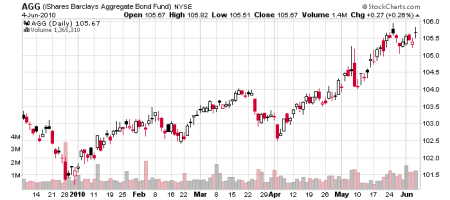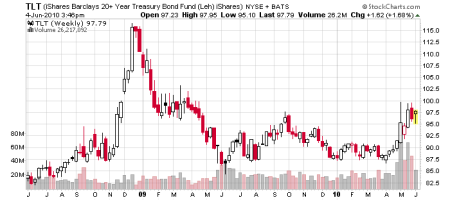I … Aggregate debt has peaked out; most debt has turned lower in value indicating a rise in interest rates globally.
The chart of Aggregate Debt, AGG, shows that it has peaked out.
US Treasuries began to fall in value on May 26, 2010; emerging market bonds fell May 14, 2010.
The Chart of US Treasury ETFs IEF, TLT, ZROS shows these have recovered their previous values and then some on the Ten Year US Note, as investors perceive these to be a safe haven investment; they are not; the rise simply reflects aversion to stocks and sovereign debt of other nations and a demand for dollars. Click on chart of IEF Weekly to enlarge.
Click on chart of TLT Weekly to enlarge.
Emerging Market Bonds, EMB, began to fall May 14, 2010.
High yield debt HYV, and distressed securities, FAGIX, turned lower May 4, 2010.
The Direxion Funds Direxion Daily 30-Year Treasury Bear 3X ETF, TMV, began to rise in value on May 26, 2010; its bottom indicates that US Treasuries as a whole have turned lower.
II … Mortgage rates began to rise the week ending May 28, 2010.
The Mortgage Bankers Association (MBA) released its Weekly Mortgage Applications Survey for the week ending May 28, 2010.
The average contract interest rate for 30-year fixed-rate mortgages increased to 4.83 percent from 4.80 percent
The average contract interest rate for 15-year fixed-rate mortgages decreased to 4.24 percent from 4.25 percent
The average contract interest rate for one-year ARMs increased to 6.96 percent from 6.83 percent
III … Stocks began to fall in Asia on May 4, 2010, and in the US on May 18, 2010. The ongoing chart of dnh, iyr ,iwm, smh, eem, ewj, fxi, iym shows the fall of stocks beginning in May 2010.
Bear market mutual funds, ukpsx, ufpix, dxdsx, uxpsx began increasing in value May 10, 2010
Bear market ETFs JPX, SRS, SJH, SSG, EEV, SMN, SMK, BZQ, SIJ, EPV, FXP, SCO, BOM began increasing in value May 10, 2010; once can see these in a Finviz screener.
Returns are as follows since April 26, 2010:
SCO, 200% inverse of crude oil +43%
BOM, 200% inverse of base metals, +41%
JPX, 200% inverse of the Pacific excluding Japan, +37%
EPV, 200% inverse of Europe, 36%
SJH, 200% inverse of Russell 2000 Value, 31%
BZQ, 200% inverse of Brazil, 28%
SMK, 200% inverse of Mexico, 25%
EEV, 200% inverse of the Emerging Markets, 24%
SSG, 200% inverse of Semiconductors, 22%
SRS, 200% inverse of Real Estate, 20%
The Russell 2000, IWM, began to fall on May 18, 2010; WisdomTree Pacific ex-Japan, DNH, began to fall May 4, 2010.
IV … Ed Morrissey of HotAir reports that the housing market is unravelling as purchase demand is in free fall in article Mortgage Applications Fall 40% In May, Lowest Level since April 1997 Thanks to an expiring tax credit, the Obama administration got some good news from the housing markets in the last couple of months. However, the underlying numbers look positively grim, and CNBC’s Diana Olick believes they predict a double-dip recession in housing for later this year. With mortgage applications hitting their lowest level in over 13 years, she has good reason to worry.
The tax credit, as I have repeatedly argued, was nothing more than a Cash for Clunkers applied to the housing market. It artificially inflated demand by stealing future sales and pushing them further up the calendar. It did not create qualified buyers; it merely incentivized qualified buyers to act immediately instead of later this year or next year.
Now, without the artificial stimulus, we will see a serious deflation of a bubble extended by government intervention in the market. That’s exactly what happened with the original housing bubble, and it’s not a coincidence that the end of an intervention takes us back to a demand level prior to the bubble’s beginnings in 1998. The interventions have only postponed the natural revaluation of assets in the wake of irrational inflation over more than a decade.
V … RISMEDIA reports that according to the Mortgage Bankers Association’s first-quarter 2010 National Delinquency Survey, more than 14% of mortgages are delinquent, making apparent the need for more agents with specific training in short sales and foreclosure avoidance options.
VI … Mike Mish Shedlock asks ECRI Leading Indicators Dip Again; Is a Double-Dip Recession Coming? and relates Consumer Spending Has Taken A Break
VII … Municipal Market A Terrible Problem, Warren Buffet Says.
Municipal Bonds, MLN, MUI, and EMI, turned lower May, 26, 2010.
VIII. Mike Mish Shedlock relates Australia Holds Rates at 4.5%; Canada is First G-7 Country to Hike and shows currency charts for the Aussie, FXA, and the Loonie, FXC, which show broadening top pattern.
IX. Yen Carry Trades unwound globally on April, 26, 2010.
The chart of the Yen, FXY, compared to the world currencies shows an unwinding of the yen carry trade throughout the world on April 26, 2010, as investors sold out of currencies and bought yen to repay their 0.25 interest loans from the Bank of Japan; this on rising risk aversion to sovereign debt default, and ending of growth opportunities as the US Federal Reserve terminated its TARP and other Quantitative Easing Facilities. It was at that time we entered into a period of competitive currency devaluation.
Disinvestment from commodities, Oil, USO, Lumber, CUT, and Base Metals, DBB, came on April 6th, as China announced credit tightening on real estate lending.
X … Tyler Durden reports that the Fed’s Central Bank Swaps Increase By $5.4 Billion To $6.6 Billion. The Fed lent out $6.6 billion in liquidity swaps this week to foreign banks, of which the biggest beneficiary was the ECB, with a 1 week swap of $5.4 billion and an 84 day swap of $1.0 billion. The only other bank receiving Fed aid was the Bank of Japan, which got $210 million. What is funny is that the ECB is now an example of just how large the FX imbalance in Europe is: the ECB has had to lend out $6.4 billion in dollars even as banks have hoarded €320 billion in euro deposits with the ECB, a new all time record. In other words, nobody wants euros, and everybody is dying to get their hands on dollars. But somehow the market is supposed to believe the funding situation in Europe is ok. Lastly, the $6.6 billion in total Fed liquidity swaps $5.4 billion greater than the prior week’s $1.2 billion.
XI … Crude Oil and Gasoline ended the week lower: Benchmark crude for July delivery lost $3.10 to settle at $71.51 per barrel on the New York Mercantile Exchange. Earlier in the session, it climbed as high as $75.42. It started the week at $73.97.
XII … Shobhana Chandra of Bloomberg reports in article Duration of Unemployment in U.S. Rises to Record 34.4 Weeks that unemployed Americans are facing the longest wait on record to find work, a sign faster economic growth is needed to reduce the jobless rate from close to a 26-year high.
The average duration of unemployment jumped to 34.4 weeks in May from 33 weeks the prior month and 16.5 weeks in December 2007, when the recession began, a Labor Department report showed today in Washington. The number of unemployed has almost doubled to 15 million since the start of worst slump since the 1930s.
“We need faster growth, because without it, we won’t get the jobs,” said Henry Mo, an economist at Credit Suisse in New York. “We are working in that direction, but it’ll take a very long time to resolve the long-term unemployment problem.
XIII … The sovereign debt market in Europe has frozen up as Keith Jenkins and Justin Carrigan of Bloomberg report on June 3, 2010: “The European Central Bank’s purchases of the region’s government bonds are failing to entice other buyers into the market, Nomura International Plc said. ‘Prospects for country spreads now look to be almost entirely dependent on central-bank purchase operations and there appears to be little buying interest elsewhere,’ Ylva Cederholm … wrote … ‘The program has been successful to the extent that it has brought some relative stability. However, it does not seem enough to generate any self-sustaining momentum and it is hard to see this changing until more concrete judgements on problem-state fiscal progress can be made.’”
XIIII … The corporate bond market in Europe and the US has seized up, that is frozen over as Sapna Maheshwari and Kate Haywood of Bloomberg report on June 2, 1010: “The market for corporate bond sales closed as concern European banks will take more write downs and losses led investors to shun all but the safest government debt. No companies issued bonds in the U.S. yesterday … The global new issue market failed to revive after declining to $70 billion last month, less than half of April’s tally and the least since August 2003.”
XV … Tyler Durden relates the US Treasury spent $2.1 trillion in debt to generate a 14 months sugar high Total US debt today was $13.06 trillion. Total debt on March 6, 2009 was $10.95 trillion. The government has spent $2.1 trillion dollars to create a bear market rally which has now fizzled, and to fund a fiscal stimulus that is now dancing its death rattle. GDP will now gradually roll over, the unemployment rate will once again start increasing, diffusion indices, manufacturing and all other economic output will begin declining.
The commodity Copper, JJC, turned lower April 14, 2010, on China credit tightening.
XVI … Conclusion: The world entered into Kondratievv Winter on May, 26, 2010, approximately seven weeks after the end of the Federal Reserve’s Quantitive Easing, when not only the stock market had sold off, but also, the US Treasuries began to fall in value.
Debt deflation is the contraction and crisis that follows credit expansion. One of the most famous quotations of Austrian economist Ludwig von Mises is that “There is no means of avoiding the final collapse of a boom brought about by credit expansion. The alternative is only whether the crisis should come sooner as the result of a voluntary abandonment of further credit expansion or later as a final and total catastrophe of the currency involved.”
John Hara provides the details of debt deflation in article Into The Abyss: The Cycle Of Debt Deflation posted in Gold Speculator as well as posted in 24HGold; and as he does, he describes the entrance into Kondratievv Winter.
Disclosure: I am invested in gold coins.



